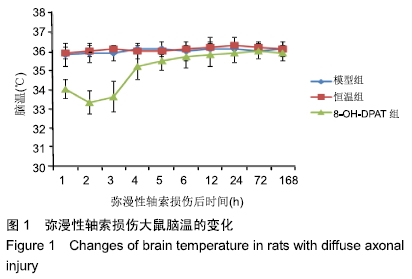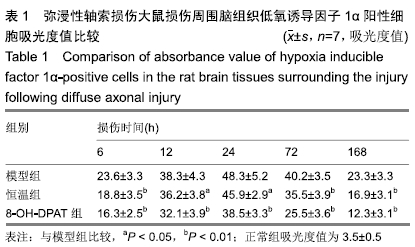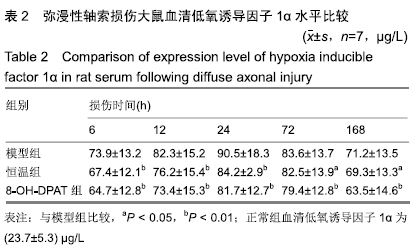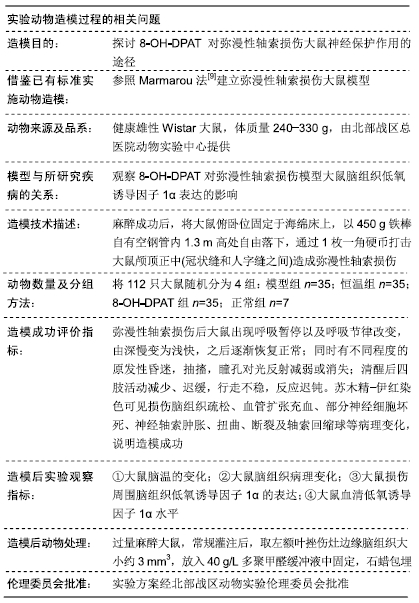中国组织工程研究 ›› 2020, Vol. 24 ›› Issue (8): 1238-1242.doi: 10.3969/j.issn.2095-4344.1975
• 组织构建实验造模 experimental modeling in tissue construction • 上一篇 下一篇
8-羟基-2-(二丙基氨基)四氢萘干预弥漫性轴索损伤模型大鼠低氧诱导因子1α的表达
毛振立1,宋振全2,张海松2,刘恩智3
- 1朝阳市中心医院神经外科,辽宁省朝阳市 122000;2北部战区总医院神经外科,辽宁省沈阳市 110016;3抚顺市中心医院神经外科,辽宁省抚顺市 113006
Effect of 8-hydroxy-2-(di-n-propylamino)tetralin on hypoxia inducible factor 1 alpha expression following diffuse axonal injury in rats
Mao Zhenli1, Song Zhenquan2, Zhang Haisong2, Liu Enzhi3
- 1Department of Neurosurgery, Chaoyang Central Hospital, Chaoyang 122000, Liaoning Province, China; 2Department of Neurosurgery, General Hospital of Northern Theater Command, Shenyang 110016, Liaoning Province, China; 3Department of Neurosurgery, Fushun Central Hospital, Fushun 113006, Liaoning Province, China
摘要:

文题释义:
8-羟基-2-(二丙基氨基)四氢萘(8-hydroxy-2-(di-n-propylamino)tetralin,8-OH-DPAT):是五羟色胺1A (5-HTlA)受体激动剂的一种,长久以来一直做为抗精神类药物被广泛研究,其在减轻焦虑和抑郁症的治疗作用的机制已经有据可查,除此以外,5-HTlA受体激动剂仍具有降低体温及神经保护作用。
脑弥漫性轴索损伤(diffuse axonal injury,DAI):是头部遭受加速性旋转外力作用时,因剪应力造成的以脑内神经轴索肿胀断裂为主要特征的损伤。一般认为,当头部加速运动时,脑组织因受瞬时产生的剪力和张力作用而发生应变,使神经轴索、毛细血管和小血管损伤。弥漫性轴索损伤好发于神经轴索聚集区,如胼胝体、脑干头端背外侧、大脑半球的灰质和白质交界处、小脑、内囊、基底节核团附近及透明隔等处。
背景:8-羟基-2-(二丙基氨基)四氢萘(8-hydroxy-2-(di-n-propylamino)tetralin,8-OH-DPAT)具有降低脑温的作用,且此作用可能是其发挥神经保护作用的潜在机制之一。
目的:观察8-OH-DPAT对弥漫性轴索损伤大鼠脑组织低氧诱导因子1α表达的影响,探讨8-OH-DPAT对弥漫性轴索损伤大鼠神经保护作用的途径。
方法:实验方案经北部战区动物实验伦理委员会批准。将Wistar大鼠随机分为4组:模型组(n=35)、恒温组(n=35)、8-OH-DPAT组(n=35)和正常组(n=7)。除正常组外,其他各组均参照Marmarou法制作弥漫性轴索损伤模型,恒温组和8-OH-DPAT组建模成功后腹腔注射8-OH-DPAT,模型组和正常组腹腔注射生理盐水;恒温组用恒温毯维持体温(37.0±0.5) ℃。每隔1 h测量大鼠脑温。分别于弥漫性轴索损伤后6,12,24,72, 168 h观察大鼠脑组织的损伤程度以及血清和损伤脑组织中低氧诱导因子1α的表达。
结果与结论:①造模后1 h,与恒温组和模型组比较,8-OH-DPAT组大鼠脑温明显下降(P < 0.05),至造模后2 h降至最低(P < 0.05),之后缓慢上升;②苏木精-伊红染色显示,模型组大鼠脑组织损伤最为严重,恒温组次之,8-OH-DPAT组损伤最轻;③免疫组织化学和ELISA结果显示,正常组血清及脑组织低氧诱导因子1α表达很低;弥漫性轴索损伤后6 h,模型组血清及脑组织低氧诱导因子1α表达增多,24 h达高峰,之后逐渐减少;与模型组比较,恒温组和8-OH-DPAT组对应时间点血清及脑组织低氧诱导因子1α表达明显减少(P < 0.05或P < 0.01),8-OH-DPAT组减少更明显(P < 0.01);④结果说明,8-OH-DPAT对弥漫性轴索损伤大鼠脑组织的神经保护作用与其降低大鼠脑温,减少损伤脑组织低氧诱导因子1α的表达有关。
ORCID: 0000-0002-4637-3553(毛振立)
中国组织工程研究杂志出版内容重点:组织构建;骨细胞;软骨细胞;细胞培养;成纤维细胞;血管内皮细胞;骨质疏松;组织工程
中图分类号:





